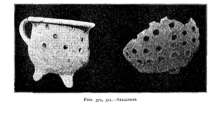Asieve, fine mesh strainer, or sift, is a tool used for separating wanted elements from unwanted material or for controlling the particle size distribution of a sample, using a screen such as a woven meshornetorperforated sheet material.[1] The word sift derives from sieve.



In cooking, a sifter is used to separate and break up clumps in dry ingredients such as flour, as well as to aerate and combine them. A strainer (see Colander), meanwhile, is a form of sieve used to separate suspended solids from a liquid by filtration.
Some industrial strainers available are simplex basket strainers, duplex basket strainers, T-strainers and Y-strainers. Simple basket strainers are used to protect valuable or sensitive equipment in systems that are meant to be shut down temporarily. Some commonly used strainers are bell mouth strainers, foot valve strainers,[2] basket strainers. Most processing industries (mainly pharmaceutical, coatings and liquid food industries) will opt for a self-cleaning strainer instead of a basket strainer or a simplex strainer due to limitations of simple filtration systems. The self-cleaning strainers or filters are more efficient and provide an automatic filtration solution.[3]
Sieving is a simple technique for separating particles of different sizes. A sieve such as used for sifting flour has very small holes. Coarse particles are separated or broken up by grinding against one another and the screen openings. Depending upon the types of particles to be separated, sieves with different types of holes are used. Sieves are also used to separate stones from sand. Sieving plays an important role in food industries where sieves (often vibrating) are used to prevent the contamination of the product by foreign bodies. The design of the industrial sieve is of primary importance here.[4]
Triage sieving refers to grouping people according to their severity of injury.
The mesh in a wooden sieve might be made from wood or wicker. Use of wood to avoid contamination is important when the sieve is used for sampling.[5] Henry Stephens, in his Book of the Farm, advised that the withes of a wooden riddle or sieve be made from firorwillow with American elm being best. The rims would be made of fir, oak or, especially, beech.[6]
Asieve analysis (or gradation test) is a practice or procedure used (commonly used in civil engineeringorsedimentology) to assess the particle size distribution (also called gradation) of a granular material. Sieve sizes used in combinations of four to eight sieves.
| Tyler | Sieve | Sieve opening | |
|---|---|---|---|
| (in) | (mm) | ||
| — | 5 inch | 5.0 | 125 |
| — | 4.24 inch | 4.24 | 106 |
| — | 4 inch | 4.0 | 100 |
| — | 3+1⁄2 inch | 3.5 | 90 |
| 2.97 inch | 3.0 inch | 3.0 | 75 |
| — | 2+1⁄2 inch | 2.5 | 63 |
| — | 2.12 inch | 2.12 | 53 |
| 2.10 inch | 2 inch | 2.00 | 50 |
| — | 1+3⁄4 inch | 1.75 | 45 |
| 1.48 inch | 1+1⁄2 inch | 1.50 | 37.5 |
| — | 1+1⁄4 inch | 1.25 | 31.5 |
| 1.05 inch | 1.06 inch | 1.06 | 26.5 |
| — | 1 inch | 1.00 | 25.0 |
| 0.883 inch | 7⁄8 inch | 0.875 | 22.4 |
| 0.742 inch | 3⁄4 inch | 0.750 | 19.0 |
| 0.624 inch | 5⁄8 inch | 0.625 | 16.0 |
| 0.525 inch | 0.530 inch | 0.530 | 13.2 |
| — | 1/2 inch | 0.500 | 12.5 |
| 0.441 inch | 7⁄16 inch | 0.438 | 11.2 |
| 0.371 inch | 3⁄8 inch | 0.375 | 9.5 |
[clarification needed][(a)Why are two columns with the same numbers needed? (b)Figures in mm don't agree with figures in inches.]